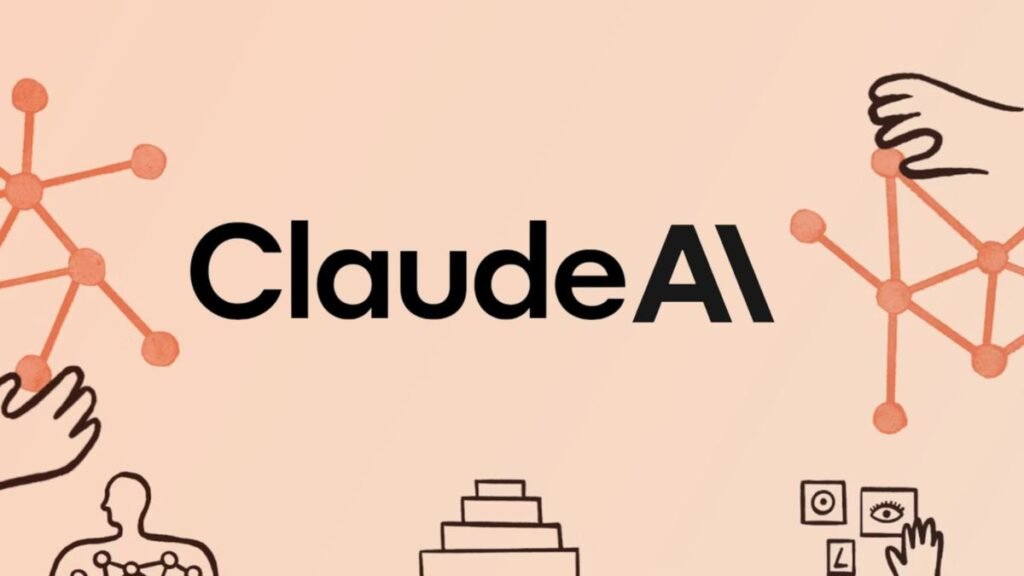In the ever-evolving race to dominate artificial intelligence, one company stands out not just for its technical prowess but for its ethical foundation: Anthropic AI. While others push the boundaries of scale and performance, Anthropic is carving a unique path by prioritising AI alignment, safety, and interpretability. Founded by ex-OpenAI researchers, the San Francisco-based startup has become a critical player in the LLM (Large Language Model) space.

With the release of its Claude family of models—named after Claude Shannon, the father of information theory—Anthropic aims to create AI that’s not only intelligent but also reliable, controllable, and aligned with human values. The company’s novel approach to model training, known as Constitutional AI, sets it apart from traditional reinforcement learning from human feedback (RLHF) systems.
This article offers a comprehensive look at Anthropic AI, including its founding story, Claude model lineup, safety research, architectural insights, key use cases, and how it compares to other industry titans like OpenAI and Mistral.
What Is Anthropic AI?
Anthropic is an AI safety and research company that develops large-scale AI systems with a focus on alignment and long-term safety. Its core belief is that future AI systems must be interpretable and steerable to be useful and trustworthy at scale.
Founded in 2021, Anthropic’s mission is to build reliable, interpretable, and steerable AI systems that benefit humanity. The company has released multiple versions of its language model, Claude, designed to generate helpful, honest, and harmless outputs across a range of tasks.
Where OpenAI has popularised ChatGPT and Microsoft-backed integrations, and Mistral has leaned into open-weight accessibility, Anthropic has positioned itself as the safety-first lab, dedicated to making AI beneficial in the long run.
Who Founded Anthropic?

Anthropic AI was co-founded by siblings Dario Amodei y Daniela Amodei, both of whom were previously key figures at OpenAI. Dario served as VP of Research and was involved in the development of GPT-2 and GPT-3. The departure from OpenAI was driven in part by differing views on AI safety and the direction of commercial deployment.
Other founding members include:
- Jared Kaplan – AI theorist and co-author of the scaling laws that underpin most LLM development today.
- Tom Brown – Architect behind GPT-3.
- Sam McCandlish, Jack Clark, and others – Seasoned researchers and policy experts in AI safety.
With backing from top-tier VCs like Spark Capital and Google, Anthropic quickly raised over $1.5 billion in funding, including significant investments from Amazon and Google Cloud.
What Is Claude AI?

Claude is Anthropic’s flagship family of large language models, positioned as a competitor to OpenAI’s ChatGPT and Google’s Gemini. The Claude series is specifically trained to be:
- Helpful: Providing accurate and context-aware answers
- Honest: Avoiding hallucinations and acknowledging uncertainty
- Harmless: Refusing to produce dangerous, toxic, or biased outputs
Claude Model Timeline
- Claude 1 (March 2023): First generation with a 9K context window
- Claude 1.2 (July 2023): More stability, improved summarisation
- Claude 2 (July 2023): 100K token context, better reasoning
- Claude 2.1 (November 2023): Enhanced tool use and memory
- Claude 3 Family (March 2024): Claude 3 Haiku, Claude 3 Sonnet, and Claude 3 Opus—marking a significant leap in performance and general intelligence
The Claude 3 series places Anthropic in the top tier of LLM performance, with Claude 3 Opus matching or surpassing GPT-4 in many benchmarks.
Constitutional AI: How Anthropic Trains Its Models
What sets Claude apart is its training methodology: Constitutional AI. Rather than relying purely on reinforcement from human feedback (RLHF), Anthropic has developed a method that uses a written set of principles—like a constitution—for guiding behaviour.
How It Works
- Supervised fine-tuning: Train the model on helpful and harmless responses.
- AI self-critique: The model critiques its own responses based on constitutional principles.
- Improvement loop: The model learns from critiques to generate better answers.
This process reduces reliance on human labellers and improves alignment scalability, meaning models can be more easily adapted to new ethical guidelines or cultural norms.
Example Principles in the Claude Constitution
- Do not provide harmful or offensive content.
- Do not provide assistance in illegal activities.
- Be respectful of privacy and personal data.
- Acknowledge when uncertain or when lacking information.
This results in models that are more cautious, introspective, and safety-aware than traditional LLMs.
Claude 3 Performance Benchmarks
Anthropic’s Claude 3 Opus is among the most powerful LLMs available as of 2024. It has demonstrated top-tier results across a variety of benchmarks:
| Benchmark | Claude 3 Opus | GPT-4 (Mar) | Gemini 1.5 Pro |
|---|---|---|---|
| MMLU | 86.8 | 86.4 | 83.0 |
| HumanEval (Code) | 74.5 | 67.0 | 71.2 |
| GSM8K (Math) | 94.2 | 92.0 | 90.5 |
| Big-Bench Hard | 83.1 | 80.9 | 81.7 |
| ARC (Challenge) | 95.3 | 93.0 | 94.5 |
Claude 3 models also support image inputs, tool use, memory features, y 100K+ context windows, making them ideal for complex enterprise workflows.
Key Use Cases for Claude AI
1. Enterprise AI Assistants
With Claude’s reliability and long memory, it’s widely used in document analysis, legal reviews, customer service, and summarisation workflows.
2. Research and Policy
Anthropic’s focus on AI alignment has made Claude a preferred tool among academic researchers, government agencies, and think tanks.
3. Coding and Debugging
Claude 3 Opus rivals GPT-4 in code understanding and generation, suitable for IDE integration, pair programming, and low-code development tools.
4. Healthcare and Finance
Industries requiring risk mitigation and compliance are increasingly choosing Claude for its cautious output style and transparency.
5. Education and Learning
Claude’s ability to explain complex concepts clearly and avoid hallucinations makes it a strong candidate for tutoring applications and knowledge bases.
Anthropic AI vs Competitors
Anthropic vs OpenAI
| Característica | Anthropic Claude 3 | OpenAI GPT-4 |
|---|---|---|
| Alignment method | Constitutional AI | RLHF |
| Transparency focus | High | Moderate |
| Model licensing | Proprietary (API only) | Proprietary (API only) |
| Safety behaviours | Strongly cautious | Equilibrado |
| Long-context support | 100K+ tokens | 128K tokens (GPT-4-t) |
Anthropic vs Mistral AI
| Característica | Anthropic AI | Mistral AI |
|---|---|---|
| Open weights | No | Sí |
| Alignment focus | Very high | Moderate |
| Local deployment | Not available | Fully supported |
| Model size | Scalable via API | Mistral 7B / Mixtral |
| Target audience | Enterprises, academia | Developers, startups |
Anthropic trades open access for control, reliability, and fine-tuned alignment, offering enterprise customers peace of mind over raw speed or openness.
Accessing Claude AI
Claude models are available via:
- Anthropic’s website (claude.ai) for public use
- Slack integration for enterprise chat support
- Amazon Bedrock (AWS) for cloud deployment
- Google Cloud Vertex AI for managed infrastructure
Claude 3 Opus is typically priced at a premium tier, with Claude 3 Sonnet offering a mid-range balance and Claude 3 Haiku serving as a lightweight model for high-speed use cases.
Model Lineup: Claude 3 Series
| Model Name | Context Window | Latency | Ideal For |
|---|---|---|---|
| Claude 3 Haiku | 200K tokens | Fastest | Chatbots, mobile apps, real-time UX |
| Claude 3 Sonnet | 200K tokens | Equilibrado | Business apps, summarisation, QA |
| Claude 3 Opus | 200K+ tokens | Most powerful | Legal, technical, and enterprise AI |
Each Claude model is trained using the same alignment principles but tuned for different performance tiers.
Anthropic’s AI Safety Research
Beyond building models, Anthropic is at the forefront of AI interpretability and robustness research. Key areas of focus include:
1. Mechanistic Interpretability
Understanding how neurons and weights in LLMs form abstractions and perform reasoning. This includes visualising activation patterns and tracing output causality.
2. Scalable Oversight
Creating methods for supervising increasingly intelligent systems without scaling human feedback linearly. Techniques include recursive reward modelling and debate systems.
3. Adversarial Testing
Regular red-teaming of Claude models to probe edge cases, jailbreaks, and ethical boundary violations.
Anthropic regularly publishes research papers, open-sources safety datasets, and collaborates with academic institutions to ensure AI development progresses responsibly.
Claude in the Cloud: Infrastructure and Partners
Anthropic has built Claude to integrate seamlessly with major cloud platforms. Key partnerships include:
- Amazon Web Services (AWS): Anthropic has committed to a long-term partnership, using AWS Trainium and Inferentia chips to train and serve Claude models at scale.
- Google Cloud Vertex AI: Claude is integrated into Google Cloud’s AI development ecosystem, offering developers low-latency and scalable endpoints.
- Notion, Zoom, Slack: Major software providers have begun embedding Claude-powered AI assistants into productivity tools.
These integrations are designed for compliance, scalability, and enterprise-grade reliability.
Claude API and Developer Access
While Claude does not have open weights, Anthropic provides a robust API for developers to build applications. Key API features include:
- Chat completions endpoint
- Streaming output
- Function calling
- Embeddings
- Tool integration
Pricing varies by model tier, with Claude 3 Opus costing more per token than Haiku or Sonnet. Token limits extend beyond 100,000 tokens per prompt, allowing full-document ingestion and complex instructions.


